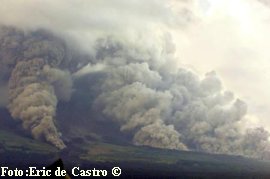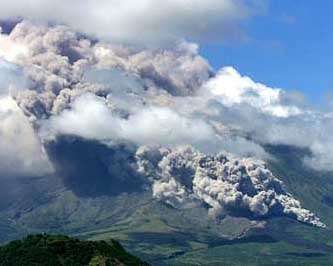|
Mayon-volcano in the Philippines is a stratovolcano, and the most
active
volcano in the islands. Mayon is situated about 330 km south of Manila,
in the province
of Albay, and reaches 2.460 meter asl. Since 1616 it has erupted 47
times.
12 of these has forced damage to property and people.
Monday, September 13th, 2004
Volcanic material was emitted by Mayon volcano late yesterday, setting
fire to grass on the
volcano's slopes. A crater glow was visible to the naked eye, indication
the proximity of magma
to the surface. Mayon volcano remains on alert level two, which means
that the volcano is
undergoing abnormal activity but an eruption is not yet imminent. There
is a six kilometer
exclusion zone around the crater.
May 20th, 2004
Phivolcs Tuesday declared a six-kilometer radius from the top of Mayon
Volcano as a
"permanent danger zone" due to instrument reading indicating
signs of moderate volcanic
unrest in the world-famous perfect cone.
This alert condition signifies a volcano instability that may eventually
lead to ash emissions
or eruption. Phivolcs reported that a total of three volcanic quakes
were recorded the past
week suggesting a renewed period of unrest for Mayon volcano. A glow
in the crater and
a moderate steaming activity were also noted.
Mayon's sulfur dioxide emission increased from the normal level of 500
tons per day
to 1,169 tons per day as of May 12
November 7th, 2002
According to news articles, the Alert Level at Mayon was raised from
0 to 1 (on a scale of 0-5) after increased seismicity and gas emission
were recorded. The amount of SO2 emitted increased from ~950 tons/per
day during the previous week, to ~2,670 tons on 29 October. Residents
near the volcano were notified that they must not enter the 6-km radius
Permanent Danger Zone, especially on the SE side of the volcano.
July 27th 2001
Following initial eruption at 7:56 AM yesterday, two more eruption episodes
occurred.
The second explosive eruption commenced at 2:20 PM until 3:00 PM yesterday
and the
third event was recorded from 5:49 PM to 6:10 PM yesterday. These eruptions
produced
life-threatening pyroclastic flows, which swept mainly the Bonga Gully
in the southeast and
the Basud Gully to the East. Smaller pyroclastic flows ran through the
Miisi and Anoling
Gullies in the south, and other flows occurred in the southwest and
western sectors.
All pyroclastic flows were contained within the six
(6) kilometer-radius Permanent Danger
Zone (PDZ). Inclement weather precluded direct observation of the ash
plume for the second
and third eruption episodes but based on ashfall in Legaspi City and
neighboring towns, it is estimated that the ash columns were similar
to the first eruption of 7:56 AM and reached 10 kilometers high and
fanned through the south-southwest and southeast.
(PHIVOLCS)
July 26th 2001

Early
this morning. Notice pyroclastic flow on right side.
( © Stringer/Philippines/Reuters)
more news instantly from Philippine Daily
Inquirer - breaking news
The Mayon volcano in the Philippines erupted today,panicking
nearby residents less than
a month after aseries of eruptions. The volcano sent a huge cauliflower-shaped
column of
ash and smoke into the air, with flows of lava down its slopes.
Late yesterday, the Philippine Institute of Volcanology
and Seismology raised the fourth-level
of a five-step volcano alert around Mayon, calling for the evacuation
of residents within a six kilometre danger zone around the volcano.
(ABC news online)
June 30th, 2001

From
the eruptioon yesterday, notice pyroclastic flows on both sides of the
volcano.

Hazard map from PHIVOLCS
June 25th 2001

Back
to his farm with his cow, he just has to..
Photo:
Manila Bulletin

From
the eruption sunday June 24th
24.juni 2001 ettermiddag




Mayon
- June 24th, 2001
January 11th, 2001
 
The
dome on February 2nd 2000 before the eruption, and the dome on January
8, 2001.
From the beginning (text in norwegian) Click here!
Just before March 18, 2000 (text in norwegian): Click
here!
| |
Linker:
|
|
|
The
Manila Times |
|
|
Philippine Daily Inquirer |
|
|
Manila
Bulletin |
|
|
PHIVOLCS -
Philippine Institute of Volcanology and Seismology |
|
|
Mayon Volcano - Journeys
to the Philippines |
|













